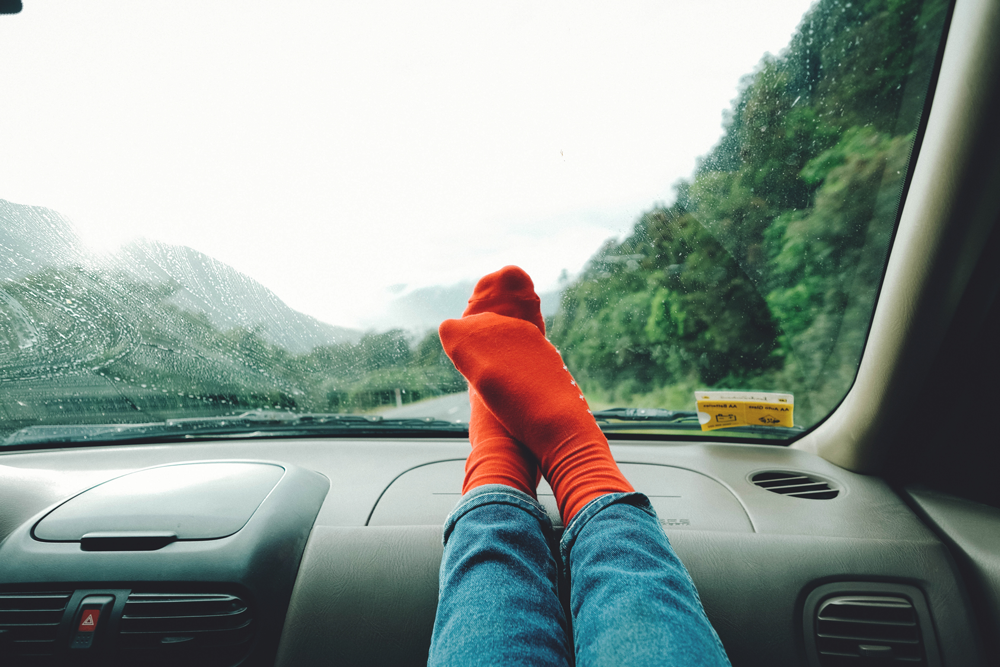Rediscover the Road Trip, Part 3 Share What Matters Most

The journey not the arrival matters.
T.S. Eliot
How much time does your family spend together on a daily basis? A recent study found that the average American family spends just 37 minutes of quality time together each day. That means with 1,440 minutes at our daily disposal, we’re spending just 2.5% of our time connecting with family.
As modern parents, we tend to consider a long road trip an annoying-but-unavoidable delay to the beginning of our vacation. A necessary evil. Something to be mitigated, rather than experienced. But if the statistics above are to be believed, one five-hour car ride is more “quality time” than the average family spends together in a whole week.
Whether we realize it or not, time in the car is part of our vacation, too. We still took time off from other commitments. We had to plan and to pack for these hours. Why not make the most of them? They might be the best time we spend together as a family all year.
It’s not just being together physically, however. We need interaction. Connection. Shared experiences. Rich conversations. All taking place away from our daily grind. This is the stuff memories are made of.
We need this journey. Perhaps even more than we need the destination.
If we truly want to find joy in the journey, there are sacrifices to be made. We have to be willing to invest the time and emotional energy required. No shortcuts. No half-hearted attempts. No blinking when we face blowback.
Because we will face blowback. Exhibit A:
Limit the screens.
As if the above statistics on family time aren’t sobering enough, compare them to this stark reality: the average person spends 116 minutes per day on social media — or three times the amount they spend with family.
However uncomfortable we might be with those statistics, can we honestly say we’re surprised? Media in general, and social media in particular, has infiltrated almost every facet of modern life, and it seems there is no end in sight.
Parents trying to keep screens in check have our work cut out for us. We set off-hours and time limits. We ban screens from the dinner table. We use the latest monitoring apps, and when all else fails, old-fashioned analog locks. We do everything in our power to keep the screens in their place.
And yet the prospect of a family road trip tends to make us consider screen indulgence with a shrug of the shoulders. “At least it will keep everyone happy,” right? (“Not so fast,” says the research.)
Screens have a way of blinding us to the world. A friend of mine told a story about driving to a rural area by following the navigation prompts on her smartphone. Just when it was time to return home, her phone died — and she couldn’t find her way back! She’d been so focused on the onscreen navigation, she missed all the real world landmarks that might have shown her the way home.
Screen time can be a useful respite, but when everyone in the car is glued to their separate devices, those screens turn into a barrier to building relationships and making memories. If you have limits on screen time at home — and you should — don’t just toss them out the window on the family road trip.
I confess that we started this all wrong. There was a time when my kids couldn’t imagine driving to their grandmother’s house (a trip of less than two hours) without watching a movie on the way. Until one time when we didn’t. Probably because I forgot to bring a device. And they survived. Now I know better. On a longer trip, I might bring something for them to watch, but I rarely break it out, unless and until there’s an “emergency.” More often than not, there isn’t one. And so we find other ways — better ways — to fill the time.
An hour of sibling bickering can bring even the most stalwart among us to the brink of insanity. I’ve been there — I get it. Tech-induced silence and harmony is available, at the low, low price of each member of the family plugging in and tuning out. It’s the promise of an easy fix.
But don’t.
The hard is what makes it great.
A league of Their own (1992)
We need to do the hard thing. Set limits on time and content. Confiscate devices and reset passwords, cold turkey, if we have to. Put down our own devices. (Ouch.) Tear down the barriers that distract and disconnect us, so we can embrace the better thing.
Share experiences and conversations.
Once we’ve emptied our children’s hands, we’ll need to fill them again — hopefully with something other than bickering and complaints. If we truly want to connect as a family, we need to share. Experiences and conversations are the key.
How does that work, exactly?
Watch the world go by.
Some of the most interesting sights I’ve seen in my life were glimpsed through a car window: A lush canopy of trees arching over the curve in a country road in my Arkansas hometown. Shingled rooftops, somewhere in Illinois, standing like islands in the yellow flood waters of the Mississippi River. A beautiful, abandoned stone farmhouse on a lonely Texas plain. The skeletal figures of blackened trees standing sentinel in a Louisiana swamp, thrown into silhouette by the colors of the setting sun. Even decades later, these scenes are chiseled on my memory.
Experience the scenery with your kids. Look for what is beautiful — or at least interesting. Talk about it together. Discuss the trees, rock formations, or cloud shapes, or the animals and birds you see. Identify the lakes and rivers you cross. Show them sand dunes, swamps, and deserts. Talk about the architecture of homes, churches, and skyscrapers. Point out bridges, railroads, oil wells, shipyards, factories, grain elevators, farm crops, barns, and battlefields.
Good conversation comes from good questions.
Good Questions about Scenery
Plot your course.
I have an unreasonable love for maps and globes. (I realize that’s a bit like loving slide rules and buggy whips, but #sorrynotsorry.) Yes, Google Maps is fantastic for practical purposes — like actually arriving at your destination — but it keeps us “zoomed in,” self-focused, and thinking small. Something about unfolding a huge map, and seeing “the big picture,” just speaks to me. Maps provide a sense of place: not just where we are, but all that is beyond us, too. A road trip is a great opportunity to usher your kids toward a love of cartography.
Give your younger children some blank paper, or the basic outline of the state you’re driving through, along with crayons or colored pencils, even stickers. Encourage them to create their own map of your trip. Sketch in some scenery and animals. Add their favorite road signs or billboards.
School-age kids can be equipped with a ruler, a notepad, a compass, and a detailed paper map. Describe your route, and encourage them to read the road signs to track your progress. Calculate average speed to predict your arrival time.
This is another opportunity ripe for discussion questions:
Good Questions about Maps
Make strategic stops.
Yes, some pit stops are out of raw necessity, and we can’t get choosy about where and when they occur. But living in the age of smartphones mean we can research almost anything in real time — which gives us a bit more freedom to be adventurous in the stops we are able to plan.
Google the historical markers and monuments along your route. Better yet, stop to stretch your legs and read some placards. (After all, what’s the rush? You’re on vacation!) Instead of stopping at a familiar fast food chain, consider a Czech bakery, or a local taco stand, or a Navajo jewelry shop. Buy sandwich supplies at a grocery store and then stretch your legs in a nearby park.
I remember stopping in Stillwater, Oklahoma, on our way to Colorado once. We explored a bit of the Oklahoma State University campus — even taking a self-guided tour of the football field at Boone Pickens Stadium, where I’m pretty sure we were not supposed to be. Ahem. Then we walked around a beautiful pond (Theta Pond, as it turns out) and took pictures of the swans. I can’t remember a “reason” for that little detour. But I’m glad we stopped nonetheless.
Play some games.
Yes, car games are corny and cheesy and decidedly uncool. But you’re allowed to be corny and cheesy and uncool with your family. Whether you bring travel-sized board games, or dive into the classic road trip games, you’re still savoring a shared experience.
There are only some ideas for experiences and conversations you can share on your road trip. I’ve got plenty more coming up in future posts. If you have some ideas of your own, share them in the comments below!
Abigail
View all posts in this series
- Rediscover the Road Trip Making Family Trips a Chance to Thrive, Not Just Survive - June 12, 2018
- Rediscover the Road Trip, Part 2 Getting There is Half the Fun - June 13, 2018
- Rediscover the Road Trip, Part 3 Share What Matters Most - June 20, 2018
- Rediscover the Road Trip, Part 4 Listen to Good Stuff - June 23, 2018







One Comment